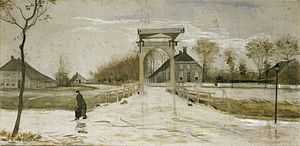Drawbridge in Nieuw-Amsterdam
 | |
| Artist | Vincent van Gogh |
|---|---|
| Year | 1883 |
| Type | Watercolor |
| Location | Groninger Museum, Groninger, Netherlands[1][nb 1] |
Drawbridge in Nieuw-Amsterdam is a watercolor created in November, 1883 by Vincent van Gogh in Drente, The Netherlands.[4]
Watercolor painting
Van Gogh wrote to his brother, Theo of the view outside his room in Nieuw-Amsterdam, Drenthe: "I now have a reasonably large room where a stove has been placed, where there happens to be a small balcony. From which I can even see the heath with the huts. I also look out on a very curious drawbridge." Within the letter he drew a sketch of the bridge, which became the watercolor, Drawbridge in Nieuw-Amsterdam.[5]
The work was one of 148 watercolors made by Van Gogh, who said of working in that medium in 1881:
What a splendid thing watercolour is to express atmosphere and distance,
so that the figure is surrounded by air and can breathe in it, as it were.[6]
Five years after having made this work, van Gogh made Langlois Bridge at Arles in France which captures a lighter mood.[7]
-

Langlois Bridge at Arles, watercolor, 1888, Private collection (F1480)
See also
- Early works of Vincent van Gogh
- Langlois Bridge at Arles (Van Gogh series)
Notes
References
- ↑ Drawbridge in Nieuw-Amsterdam. Van Gogh Museum. Retrieved September 29, 2012.
- ↑ Carl Nordenfalk. The Life And Work Of Van Gogh. Kessinger Publishing; 31 July 2006. ISBN 978-1-4286-5725-0. p. 205.
- ↑ George McDonald. Frommer's Belgium, Holland and Luxembourg. John Wiley & Sons; 26 April 2011. ISBN 978-0-470-88766-0. p. 414.
- ↑ Drawbridge in Nieuw-Amsterdam. The Vincent van Gogh Gallery. Retrieved September 29, 2012.
- ↑ To Theo van Gogh. Nieuw-Amsterdam, Friday, 12 or Saturday, 13 October 1883. Van Gogh Letters. Retrieved September 29, 2012.
- ↑ The Watercolours. The Vincent van Gogh Gallery. Retrieved September 29, 2012.
- ↑ Fred Orton; Griselda Pollock. Avant-Gardes and Partisans Reviewed. Manchester University Press ND; 15 February 1997. ISBN 978-0-7190-4399-4. p. 361.
Further reading
- John E. Sweetman. The artist and the bridge: 1700-1920. Ashgate; 1999. ISBN 978-0-7546-0013-8.
.jpg)